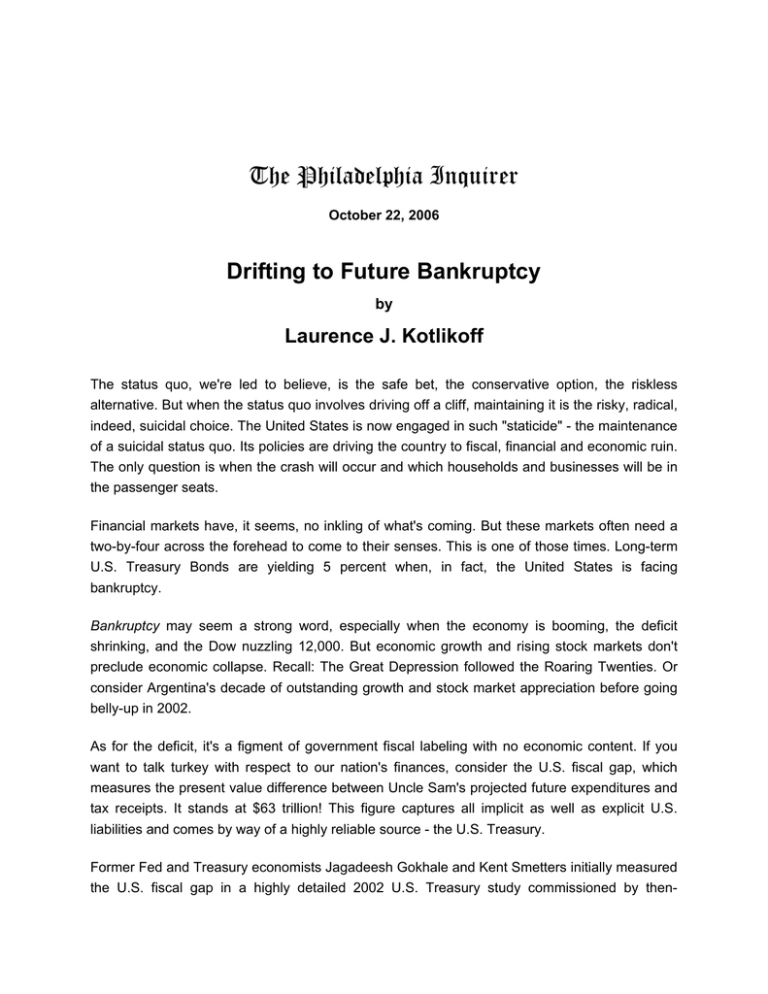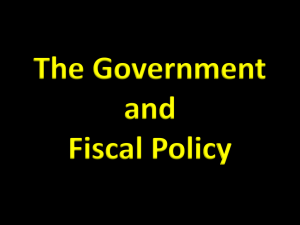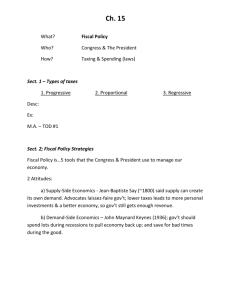The Philadelphia Inquirer Drifting to Future Bankruptcy Laurence J. Kotlikoff
advertisement

The Philadelphia Inquirer October 22, 2006 Drifting to Future Bankruptcy by Laurence J. Kotlikoff The status quo, we're led to believe, is the safe bet, the conservative option, the riskless alternative. But when the status quo involves driving off a cliff, maintaining it is the risky, radical, indeed, suicidal choice. The United States is now engaged in such "staticide" - the maintenance of a suicidal status quo. Its policies are driving the country to fiscal, financial and economic ruin. The only question is when the crash will occur and which households and businesses will be in the passenger seats. Financial markets have, it seems, no inkling of what's coming. But these markets often need a two-by-four across the forehead to come to their senses. This is one of those times. Long-term U.S. Treasury Bonds are yielding 5 percent when, in fact, the United States is facing bankruptcy. Bankruptcy may seem a strong word, especially when the economy is booming, the deficit shrinking, and the Dow nuzzling 12,000. But economic growth and rising stock markets don't preclude economic collapse. Recall: The Great Depression followed the Roaring Twenties. Or consider Argentina's decade of outstanding growth and stock market appreciation before going belly-up in 2002. As for the deficit, it's a figment of government fiscal labeling with no economic content. If you want to talk turkey with respect to our nation's finances, consider the U.S. fiscal gap, which measures the present value difference between Uncle Sam's projected future expenditures and tax receipts. It stands at $63 trillion! This figure captures all implicit as well as explicit U.S. liabilities and comes by way of a highly reliable source - the U.S. Treasury. Former Fed and Treasury economists Jagadeesh Gokhale and Kent Smetters initially measured the U.S. fiscal gap in a highly detailed 2002 U.S. Treasury study commissioned by then- Treasury Secretary Paul O'Neal and approved by Fed leader Alan Greenspan. The study, which showed a $45 trillion gap, was censored the day O'Neal was fired (actually drop-kicked) by the White House. Four years later, after more tax cuts, huge discretionary spending increases, the dramatic expansion of Medicare to cover prescription drugs, and the accrual of interest, Gokhale and Smetters put the fiscal gap at $63 trillion. This figure is massive. If anything, it's an underestimate since it relies on highly optimistic longevity and health-care spending assumptions. To sense why the U.S. fiscal gap is so big, multiply $30,264 by 77 million. This $30,264 figure is 80 percent of U.S. per capita GDP. It's also what today's seniors are receiving each year, on average, in Social Security, Medicare and Medicaid benefits. The 77 million is the number of boomers poised to start collecting these benefits. The product of the two numbers is $2.3 trillion. This is what the United States would spend this year were today's elderly as numerous as tomorrow's. If $2.3 trillion sounds big, it is. It's 18 percent of our $13 trillion economy. But were today tomorrow, we'd be paying the boomers much more than $30,264 per head, since the healthcare component of this figure is set to grow much more rapidly than per-capita GDP. An optimistic forecast would increase the $30,264 by 50 percent, raising our today-is-tomorrow senior spending from 18 to 26 percent of GDP. Today's actual senior spending is only 9 percent of GDP. Another way to assess U.S. insolvency is to consider the immediate and permanent fiscal adjustments needed to close the country's fiscal gap. Here are some options: a 70 percent increase in personal and corporate income taxes; a 109 percent hike in payroll taxes; a 91 percent cut in federal discretionary spending; or a 45 percent cut in Social Security and Medicare benefits. Adopting any of these policies or some combination of them would be incredibly painful. Waiting is no alternative. It just makes the requisite adjustments larger and more painful. What about economic growth? Can't the United States outgrow its obligations? Theoretically yes, but practically no. The postwar norm is for senior benefits to grow roughly twice as fast as the economy. Yes, there are ways to restructure U.S. entitlements to limit benefit growth and still save the day. But Washington has no appetite for anything radical. Indeed, Washington's concerted approach to our nation's demographic/fiscal crisis is to ignore it. This "What? Me Worry?" attitude is in marked contrast to that of America's trading partners in Europe and Japan. These countries face much worse demographics. But Japan, Italy, Germany, the United Kingdom, and other countries - even France - have enacted major pension changes. And each of these countries has direct control of its health-care expenditures. For its part, the United States has made no serious changes to Social Security since 1983; has a unique fee-for-service system in which health-care spending is on autopilot; and has just taken steps to expand, dramatically and permanently, its health-care spending. As a result, the United States may well be in worse fiscal shape than any other developed country and, indeed, most developing countries, including Turkey, Brazil and Argentina. Knowing this for sure is difficult since we have no systematic cross-country fiscal-gap statistics. Instead, we have inherently meaningless official statistics on explicit debts and deficits. In the United States, official debt in the hands of the public is roughly $5 trillion - a small fraction of the country's true $63 trillion liability. The U.S. fiscal excesses are showing up, however, in other ways and in other statistics. Take the nation's incredibly low national savings rate - 2 percent now vs. 12 percent in the 1960s. This long-term consumption spree primarily reflects household, not government, spending patterns. And within the household sector, it's the elderly whose consumption has risen. Indeed, average consumption of 70-year-olds compared with that of 40-year-olds has roughly doubled since the early 1960s. Low U.S. savings means low investment in the United States - unless foreigners do the investing. This is precisely what is happening and why the U.S. current-account deficit, which measures net investment in the United States by foreigners, is so big. Today, foreigners are investing four dollars in the United States for every dollar invested by Americans. Much of this foreign investment comes as purchases of U.S. financial securities, particularly U.S. government bonds. China alone holds close to $750 billion in U.S. Treasuries. Overall, 40 percent of U.S. Treasuries are held outside the country. Once foreign as well as American bondholders get a real whiff of America's true fiscal straits, they will dump their bonds. They will do so with the knowledge that countries that cannot pay their bills end up defaulting on their debt either explicitly or implicitly by printing money. Resorting to the mint or printing press to finance spending dates at least to Rome of the third century. But such a practice means one sure thing - inflation. And given the degree to which U.S. spending is explicitly and implicitly linked to inflation, it will mean high inflation if not hyperinflation. This, in turn, will mean high interest rates, plunging bond and stock prices, a rapidly declining dollar, and a major and sustained decline in U.S. economic performance. Is fiscal and economic collapse inevitable? No. Were I made Economic Czar for a day, I would implement the New New Deal - four simple, transparent, efficient, equitable, and radical changes in Social Security, health care, tax and government spending, discussed in an article I wrote with Niall Ferguson. Done together, the changes we propose could restore fiscal sanity and avoid our nation's coming generational storm. Unfortunately, the politicians have no stomach for sensible, but radical solutions. I sent the article to all 100 U.S. senators. Not one replied. (So much for my hopes of Czardom!) So be forewarned. Things are heading south. The real question is how to stay solvent when Uncle Sam crashes and burns. Here's how: A borrower, not a lender be. Dump your dollar-denominated long-term bonds and borrow on a long-term basis. You'll avoid a capital loss on the bonds you sell and get to repay your borrowing in watered-down dollars. Invest in Canada, New Zealand, the United Kingdom, and other countries whose fiscal gaps are close to zero. Position yourself against a drop in the dollar. Consider only U.S. investments that are relatively inflation-proof, such as Treasury Inflation Indexed bonds, commodities, and real estate (once it tanks). Put yourself and your workers into Roth 401(k)s so they won't get clobbered by future tax increases. Plan for the downside. When the U.S. economy tanks, make sure you aren't dependent solely on the U.S. market to make a buck. Finally, hire a big-time K Street lobbyist to get Congress to stop pursuing staticide and close the U.S. fiscal gap. Laurence J. Kotlikoff is Professor of Economics, Boston University




